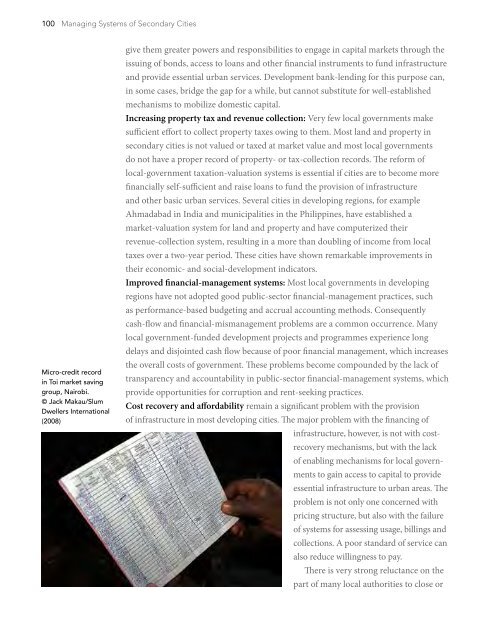DYhWN
DYhWN
DYhWN
Create successful ePaper yourself
Turn your PDF publications into a flip-book with our unique Google optimized e-Paper software.
100 Managing Systems of Secondary CitiesMicro-credit recordin Toi market savinggroup, Nairobi.© Jack Makau/SlumDwellers International(2008)give them greater powers and responsibilities to engage in capital markets through theissuing of bonds, access to loans and other financial instruments to fund infrastructureand provide essential urban services. Development bank-lending for this purpose can,in some cases, bridge the gap for a while, but cannot substitute for well-establishedmechanisms to mobilize domestic capital.Increasing property tax and revenue collection: Very few local governments makesufficient effort to collect property taxes owing to them. Most land and property insecondary cities is not valued or taxed at market value and most local governmentsdo not have a proper record of property- or tax-collection records. The reform oflocal-government taxation-valuation systems is essential if cities are to become morefinancially self-sufficient and raise loans to fund the provision of infrastructureand other basic urban services. Several cities in developing regions, for exampleAhmadabad in India and municipalities in the Philippines, have established amarket-valuation system for land and property and have computerized theirrevenue-collection system, resulting in a more than doubling of income from localtaxes over a two-year period. These cities have shown remarkable improvements intheir economic- and social-development indicators.Improved financial-management systems: Most local governments in developingregions have not adopted good public-sector financial-management practices, suchas performance-based budgeting and accrual accounting methods. Consequentlycash-flow and financial-mismanagement problems are a common occurrence. Manylocal government-funded development projects and programmes experience longdelays and disjointed cash flow because of poor financial management, which increasesthe overall costs of government. These problems become compounded by the lack oftransparency and accountability in public-sector financial-management systems, whichprovide opportunities for corruption and rent-seeking practices.Cost recovery and affordability remain a significant problem with the provisionof infrastructure in most developing cities. The major problem with the financing ofinfrastructure, however, is not with costrecoverymechanisms, but with the lackof enabling mechanisms for local governmentsto gain access to capital to provideessential infrastructure to urban areas. Theproblem is not only one concerned withpricing structure, but also with the failureof systems for assessing usage, billings andcollections. A poor standard of service canalso reduce willingness to pay.There is very strong reluctance on thepart of many local authorities to close or


